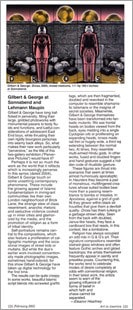
Gilbert & George at Sonnabend and Lehmann Maupin
By Eleanor Heartney
Gilbert & George have long trafficked in perversity, filling their large, gridded photoworks with monumental paeans to body fluids and functions, and lustful considerations of adolescent East End boys, while thrusting their own rigidly bourgeois personas into seamy back alleys. So, what makes their new work particularly "perversive," as the title of this two-gallery exhibition ("Perversive Pictures") would have it?
Perhaps it is not so much the work as the world that it reflects which is increasingly perverse. In this series (dated 2004), Gilbert & George touch on some unsettling contemporary phenomena. These include the growing appeal of Islamic fundamentalism in immigrant communities like their own London neighborhood of Brick Lane; the strange stew of class resentment, anarchic rhetoric and seductive violence cooked up in inner cities and glamorized by the media; and the promotion of religion as a form of tribal identity.
Self-portraiture remains central to the compositions, which also feature a proliferation of calligraphic markings and the occasional images of street kids or mullahs. But while the duo's earlier work involved conventionally made photographic images, sometimes hand-colored, for this show Gilbert & George have taken up digital technology for the first time.
The results can be quite creepy. In some works, beautiful Islamic script blends into scrawled graffiti tags, which are then fragmented, doubled and reworked in the computer to resemble shamanistic talismans or the insignia of secret societies. Meanwhile, Gilbert & George themselves have been transformed into fantastic mutants. We see frontal heads on bodies viewed from the back, eyes melding into a single Cyclopian orb or proliferating on expanding heads, torsos made rail thin or hugely wide, a third leg extending between the normal two. At times, they resemble multi-armed Hindu gods. In other works, fused and doubled fingers and hand gestures suggest a hidden code of ritualistic gesture.
These figures are thrust into scenarios that seem at times almost humorously apocalyptic. In Haunters they become a pair of monstrous, multifingered creatures whose suited bodies bear more than a passing resemblance to bombs or missiles. In Apostasia, against a grid of graffiti they glower within black silhouettes that give them a devilish quality. Dross has them lurking in a garbage-strewn alley. Seen from the back with doubled, Janus-like heads, they face a cardboard box that reads, in this context, like a tombstone.
Religion has always occupied an odd role in G & G's art. Their signature compositions resemble stained-glass windows and often feature Gothic arches and gilded backdrops; the artists themselves frequently appear in saintly and priestlike poses. Countering this, the works tend to celebrate modes of desire completely at odds with conventional religion. In their latest work, the artists seem to warn of the growing influence of forms of belief in which faith and chaos cannot be separated.
